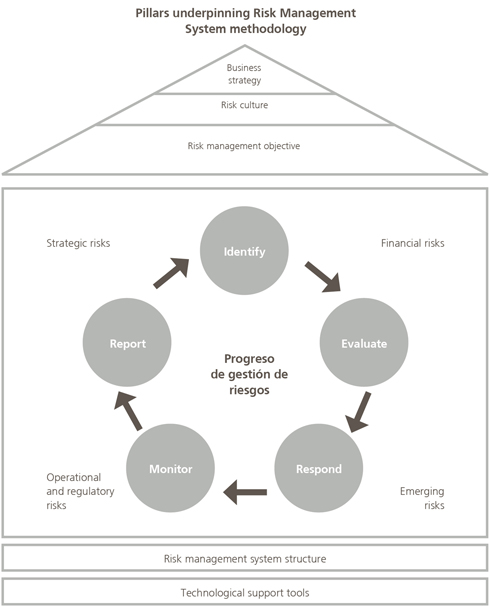 Abengoa
Abengoa
Annual Report 2011
- Corporate Social Responsibility
- Corporate governance, transparency and rigor in management
- Risk management model
Abengoa’s Universal Risk Model comprises a total of 94 main risks that may affect company business.

For each risk, a monitoring procedure has been set up, along with at least one quantitative indicator and a level of tolerance that rates the risk depending on the likelihood of occurrence and the potential impact for the company.

The Abengoa Risk Model is reviewed periodically and falls under the responsibility of the Internal Auditing Department, those in charge of the indicators, and heads of Corporate Risk Management. The company designs and plans measures for mitigating relevant risks based on this model.
Risk management philosophy is reflected in and applied through the Abengoa Risk Management System, illustrated below as follows:

The response mechanisms devised and included under the different Abengoa risk management systems are intended to:
- Eliminate risk.
- Control and minimize risk as far as possible using strategic or security measures (supply diversification, and quality, maintenance, prevention and other systems).
- Third-party transfer so that Abengoa is in no way held liable for the risk, either through an insurance firm or other third party (supplier, subcontractor).
- Financial withholding, in the event that it is not possible to otherwise control the risk involved.


eCRM development
Implementation of the Archer eCRM solution began in 2010. This technological solution enables automation of the process of determining, evaluating, responding to, monitoring and reporting on risks that make up the Abengoa Universal Risk Model.
This technological solution began to use in 2011, helping to automate all processes involved in risk management for the entire range of business activities and sectors, while at the same time tailoring risk evaluation, response, monitoring and reporting to reflect all company activities and sectors through a common standardized and centralized methodology.
© 2011 Abengoa. All rights reserved
